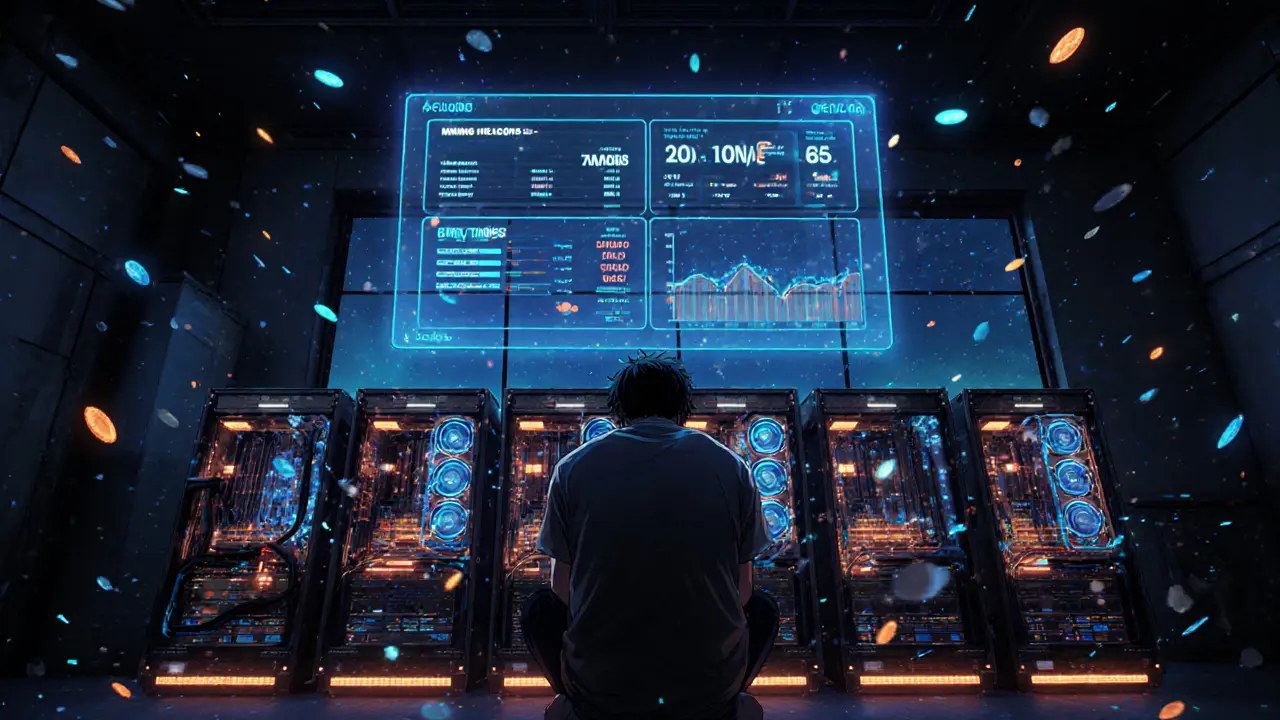Mining Profitability Calculator
When Bitcoin first launched, mining was something anyone could do with a regular computer. But today, finding a new block solo is like trying to win the lottery every few years-except the odds are worse. That’s where cryptocurrency mining pools come in. They’re not fancy software or secret clubs. They’re simply groups of miners who team up to share the work-and the rewards.
Why Mining Pools Exist
Mining Bitcoin or other proof-of-work cryptocurrencies isn’t just hard-it’s mathematically random. Each block requires solving a complex puzzle. The first miner to solve it gets the reward: currently 3.125 BTC (about $200,000 as of late 2025) plus transaction fees. But if you’re using a single ASIC miner with 100 TH/s, you might wait over three years to find a block on your own. Most people can’t afford to wait that long-or afford the electricity bills in the meantime. Mining pools solve this by combining the computational power of hundreds or thousands of miners. Instead of waiting years for one big payout, you get small, regular payments every day. It’s the difference between buying one lottery ticket and joining a syndicate that buys 10,000 tickets together. The first mining pool, Slush Pool, started in 2010. Back then, even a modest rig had a shot at mining a block. But as difficulty climbed, solo mining became impossible for all but the biggest operations. Today, over 90% of Bitcoin miners use pools. Without them, most people wouldn’t mine at all.How a Mining Pool Works
Here’s how it actually works under the hood:- You connect your mining hardware (like an Antminer S21) to a pool server using software like CGMiner or BFGMiner.
- The pool assigns you a range of possible solutions (called nonces) to test.
- Every time your miner finds a solution that’s close to the correct one (but not quite), you submit a “share.” Shares prove you’re doing work-they don’t earn you the block reward.
- When the pool as a whole finds a block, the reward is split among all miners based on how many shares they contributed.
Payout Methods: How You Get Paid
Not all pools pay the same way. The method affects how often you get paid and how stable your income is. Here are the most common models:- Proportional (PROP): Rewards are split based on your share of total work during the round. Simple, but you get nothing if the pool doesn’t find a block.
- Pay-Per-Share (PPS): You get paid immediately for every valid share you submit, regardless of whether the pool finds a block. Lower risk, but higher fees (usually 2-4%).
- Score-Based (Slush Pool style): Recent shares count more than older ones. This discourages miners from switching pools mid-round.
- Pay-Per-Last-N-Shares (PPLNS): You’re paid based on your shares in the last N shares before a block was found. It’s fairer than PROP but has more variance.

Top Mining Pools in 2025
As of October 2025, just a handful of pools control most of Bitcoin’s hashrate. Here are the leaders:| Pool Name | Hashrate Share | Fees | Best For |
|---|---|---|---|
| Foundry USA | 28.1% | 0% | Institutional miners, U.S.-based |
| AntPool | 22.7% | 2.5% | Global miners, auto-conversion options |
| F2Pool | 14.3% | 3% | Chinese-speaking miners, altcoins |
| Viabtc | 9.8% | 2.5% | Altcoin mining, low minimum payout |
| Luxor | 5.2% | 2.5% | North American miners, compliance features |
Pros and Cons of Joining a Pool
Pros:- Steady daily income instead of waiting years for one payout
- Lower barrier to entry-you don’t need massive hardware
- Most pools offer easy setup guides and 24/7 support
- You can mine altcoins like Litecoin or Bitcoin Cash with the same setup
- You give up full control-you’re trusting the pool operator
- Fees eat into profits (1-4% is standard)
- Pools can change fees without warning-F2Pool’s 2024 fee hike sparked backlash
- Centralization risk: top three pools control over 65% of Bitcoin’s hashrate
What to Look for When Choosing a Pool
If you’re new to mining, here’s what actually matters:- Fees: Lower is better, but don’t sacrifice reliability. A 1% fee with great uptime beats a 0% fee that goes offline weekly.
- Minimum Payout: Some pools pay out at 0.001 BTC ($60), others at 0.01 BTC ($600). Pick one that matches your hashrate.
- Server Location: Pick a pool with servers close to you. Latency causes “stale shares,” which can reduce your earnings by 3-7%.
- Support: AntPool and Luxor have English and Chinese support teams. Smaller pools? You’re on your own.
- Regulatory Compliance: If you’re in the U.S. or EU, avoid pools that don’t follow KYC rules. The EU’s MiCA law requires full compliance by January 2025.

Common Mistakes New Miners Make
Based on Reddit threads and support forums, here are the top errors:- Wrong worker name: 37% of new miners misconfigure their worker ID and get zero shares.
- Ignoring pool fees: Some think “0% fee” means free money. They forget electricity and hardware costs.
- Using outdated software: Old versions of CGMiner don’t support Stratum V2 and lose efficiency.
- Miner location: A miner in Texas connecting to a pool in China will have high latency. Use a pool with U.S. servers.
- Expecting quick profits: Mining isn’t passive income. It’s a business with overhead. You need to track electricity costs per kWh.
The Future of Mining Pools
The mining pool landscape is changing fast. In September 2024, P2Pool launched a decentralized version using merge-mining with Namecoin. It removes the central operator entirely-but rewards are more unpredictable. It’s still niche, but it’s a sign of where some miners want to go. On the other hand, Bernstein Research predicts the top five pools will control 75% of Bitcoin’s hashrate by 2026. Economies of scale favor big operators. Smaller pools are vanishing. Regulation is the biggest wildcard. The U.S. and EU now treat mining pools as money services businesses. That means they must collect KYC info, report transactions, and freeze suspicious accounts. Many small pools shut down in 2024 because they couldn’t afford compliance. Long-term, Bitcoin’s block reward will keep halving. By 2140, it’ll be zero. Miners will rely entirely on transaction fees. If fees don’t rise 12.7x from today’s levels, mining profitability collapses-and so do the pools.Final Thoughts
Cryptocurrency mining pools aren’t perfect. They’re centralized, sometimes opaque, and occasionally risky. But they’re also the only reason most people can mine Bitcoin at all. Without them, mining would be a hobby for billionaires and data centers. If you’re serious about mining, join a pool. Pick one with low fees, good uptime, and servers near you. Don’t chase the lowest fee if it means unreliable payouts. And always track your electricity costs-you’re running a business, not playing a game.Are mining pools safe?
Mining pools are generally safe if you choose reputable operators. Foundry USA, AntPool, and Luxor have strong track records. But since pools control your payouts, there’s counterparty risk-if a pool operator disappears or refuses to pay, you lose your earnings. Always check reviews and avoid pools with a history of payment delays.
Can I mine without joining a pool?
Technically yes, but it’s not practical for most people. With today’s Bitcoin difficulty, a single ASIC miner would statistically find a block once every 3.5 years. That means you’d wait over a thousand days for a single payout. Most miners use pools because they offer daily income instead of waiting decades.
Do mining pools charge monthly fees?
No. Mining pools charge a percentage of your earnings-not monthly fees. Most charge between 1% and 4% of the block reward you earn. Some, like Foundry USA, charge 0%. You only pay when you get paid.
Which cryptocurrency is best to mine in a pool?
Bitcoin is the most profitable overall, but it requires expensive hardware. For smaller miners, Litecoin, Dogecoin, and Bitcoin Cash are better options. They have lower difficulty and can be mined with older ASICs. Always compare profitability using a mining calculator before choosing.
Do I need to report mining pool income to the IRS?
Yes. In the U.S., mining rewards are considered taxable income at their fair market value on the day you receive them. This applies whether you mine solo or through a pool. You must report this on Form 1040, Schedule 1. Keep records of your payouts and the USD value at the time of receipt.


16 Responses
Man, I started mining last year with a used Antminer S19 and thought I was gonna get rich overnight. Turns out I was just paying for electricity and feeling sad every time my rig got hot. Pools saved my sanity. Got paid $40 last week. Not rich, but at least I’m not broke.
you ever wonder why all the big pools are in the usa? theyre not just mining btc theyre feeding data to the nsa. every share you submit is a little fingerprint. the gov owns the blockchain now. dont trust the pool. dont trust the miner. dont trust the wire.
Hi everyone! Just wanted to say if you’re new to mining pools, don’t stress about picking the ‘perfect’ one. Start with Luxor or Slush - they’re beginner-friendly, have great docs, and actually answer support tickets. And yes, electricity cost is your real enemy. Track your kWh like it’s your last snack in the pantry. You got this!
Everyone’s acting like mining pools are some kind of miracle. Newsflash: they’re centralized, fee-hungry middlemen that turned Bitcoin into a corporate utility. If you’re not running your own node and mining solo, you’re not even part of the movement. You’re just a renter in someone else’s digital apartment. Wake up.
PPS > PROP. Always. Latency kills. Server proximity > fee %.
I remember when you could mine with your laptop and not feel like you were running a small power plant. Now I’ve got three Antminers in my garage and my electric bill is higher than my rent. But hey - I’m part of something bigger. Even if it’s just a tiny fraction of a Satoshi every day. That’s the dream right
Only Americans and Europeans get to use these ‘compliant’ pools. Meanwhile, real miners in Africa and Asia get shafted by KYC rules they didn’t ask for. The West is turning Bitcoin into a gated community. You think you’re free? You’re just a regulated asset. Pathetic.
Just wanted to say thank you to the person who wrote this. I was so lost when I started. Your breakdown of payout methods actually made me feel less dumb. Also, I cried a little when I got my first PPS payout. It was $2.17. But it was mine.
Most people don’t even know what a share is. They think if they plug in their miner and see ‘connected’ on the dashboard they’re earning. No. A share is just proof you did the work. It’s not money. It’s like handing your boss a completed worksheet and thinking you just got paid. The block reward is the paycheck. The shares are just your attendance log. And if your pool uses PPLNS and doesn’t find a block for 10 days? You get zip. Zero. Nada. That’s why PPS is the only way for normal people. Stop listening to crypto bros who say ‘trust the process’ - trust the math. And always check your worker ID. I’ve seen 37% of new miners mess that up - it’s not a myth, it’s a tragedy.
bro why are you even doing this? you know the whole thing is rigged right? you’re just feeding data to the elite while your AC runs 24/7. just go get a job. at least you’ll get paid in cash that doesn’t vanish when the power goes out.
It’s funny how we think we’re reclaiming financial sovereignty by mining… but we’re just optimizing our contribution to a system that still needs banks, regulators, and power grids. Maybe the real revolution isn’t in the blockchain - it’s in asking why we’re so eager to play the game at all.
Anyone else notice how F2Pool’s fees went up and then their website went down for a week? I lost three days of shares. No email. No update. Just silence. I switched to AntPool after that. Never trust a pool that doesn’t reply to a ticket
While I appreciate the technical overview, I must emphasize that the geopolitical implications of mining pool centralization are not merely economic but existential. The concentration of hash power within Western jurisdictions constitutes a systemic vulnerability that undermines the very decentralization ethos upon which Bitcoin was founded. One must consider the long-term ramifications of regulatory capture.
you think mining pools are bad? wait till you see the guy who runs the pool. he’s probably got a private jet and a penthouse in Dubai while you’re sweating over your ASIC in a basement with a fan blowing on it. this whole thing is a pyramid scheme dressed in blockchain pajamas. I’d rather mine gold with a shovel and a dream.
Irish miner here. We don’t have the luxury of cheap power like the US. My electricity costs 0.30€/kWh. PPS is my only option. But I still feel like I’m funding Silicon Valley billionaires. The irony? I’m paying to mine a currency that’s supposed to break their system.
Everyone’s so obsessed with pools and fees but nobody talks about how miners are just the new serfs. You work 24/7 for a digital lord who takes 2-4% and calls it ‘service’. Meanwhile, the real power is in the ASIC factories in China and the energy monopolies in Texas. You’re not a pioneer. You’re a cog. And when the block reward hits zero? You’ll be the one holding the empty machine while the elite laugh. Wake up. This isn’t freedom. It’s feudalism with crypto hashtags.